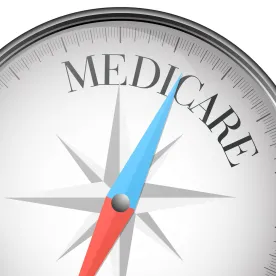A new study by Stanford University researchers finds that Medicare Advantage plans pay lower prices than traditional fee-for-service (FFS) Medicare for most types of hospital admissions. According to the study—published earlier this month in Health Affairs—Medicare Advantage plans pay hospitals about 8% less than FFS Medicare for the same services. These findings may come as a surprise to policy experts, as commercial insurers for the non-elderly generally pay far higher prices than FFS Medicare.
Medicare Advantage: More Cost-Effective Than FFS Medicare?
Medicare Advantage is the private insurance alternative to traditional Medicare. Although sold and run by private insurance companies, plan benefits are regulated and funded by the Centers for Medicare & Medicaid Services (CMS). About one-third of the Medicare population is enrolled in a Medicare Advantage plan, which commonly features a more restrictive provider network, such as an HMO or PPO. While enrollment in these plans has tripled over the last decade, the majority of seniors opt for coverage under traditional FFS Medicare.
Lacking access to comprehensive pricing data, health policy experts have disagreed on whether Medicare Advantage is more or less expensive than the public program. While some experts argue that Advantage plans offer better-coordinated care and higher quality at a lower cost, there are also concerns that the plan’s cost-savings increase private insurer profits without reducing public expenditures.
The Stanford study is the first systematic analysis to compare the unit prices paid to hospitals by Medicare Advantage relative to FFS Medicare. Using pricing data from CMS and the Health Care Cost Institute (HCCI) for years 2009, 2011 and 2012, the analysis includes information from almost one-third of Medicare Advantage enrollees and all FFS Medicare payment data.
According to the analysis, Medicare Advantage plans pay hospitals 8% less than FFS Medicare. Taking into account the narrower networks of Advantage plans, the program still pays 5.6% less than FFS Medicare for the same services.
The study’s data suggest that Medicare Advantage plans may set prices more effectively than FFS Medicare, which could lower the costs of covering seniors without sacrificing volume or quality.
Commercial Plans Pay Higher Prices, Driven by Provider Market Power
The Stanford researchers also found that commercial insurers pay hospitals far more than Medicare for the same services. Data from the Center for Studying Health System Change (HSC) has already demonstrated that private health plans for the non-elderly (employer sponsored or self-insured) pay 147 to 210 percent more to hospitals than FFS Medicare, and up to as much as 400 percent more in certain markets.
According to the Stanford study, commercial plan hospital payments have increased from approximately 146 percent of FFS Medicare payments to 165 percent from 2009 to 2012. While higher prices for profitable service lines (e.g. interventional cardiology, orthopedics) are important factors driving private insurer costs, the study’s authors argue that hospital market power is an important cause of high commercial-plan prices.
While privately-run Medicare Advantage plans may be more susceptible to hospital’s market power than FFS Medicare, they can set lower prices through competition among providers, assigning more appropriate values to services than FFS Medicare’s administrative pricing system, and steering enrollees to in-network providers.
The report concludes: “Our work echoes the growing concerns expressed by several researchers about the consequences of high commercial-plan prices for health spending… investigation of the role of market power in the process of determining Medicare Advantage prices is an important topic for future research.”
Katherine Fragoso is co-author of this article.



 />i
/>i

